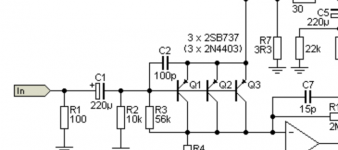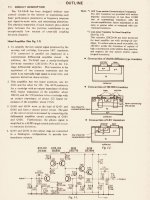Hopefully someone can help me with this as I am right up on the precipice of the limit of my knowledge.
I am designing a balanced phono amp with a differential input stage made of parallel transistors.
If I initially design for lowest noise (source resistance and collector current) for a single transistor and then add in the additional paralleled transistors do I have to increase collector current in order to get the benefit?
Also what happens in regards to the source resistance? Is it “split” between the transistors? ie. 1 BJT with 100 ohms source resistance, if I now have 5 BJTs is the source resistance For each individual BJT still 100 ohms or not?
Thanks.
I am designing a balanced phono amp with a differential input stage made of parallel transistors.
If I initially design for lowest noise (source resistance and collector current) for a single transistor and then add in the additional paralleled transistors do I have to increase collector current in order to get the benefit?
Also what happens in regards to the source resistance? Is it “split” between the transistors? ie. 1 BJT with 100 ohms source resistance, if I now have 5 BJTs is the source resistance For each individual BJT still 100 ohms or not?
Thanks.
LM194 are obsolete parts, not recommended for new builds.
Using parallel discretes is an old fashioned but worthwhile option. The reason that noise is produced in a transistor is due to holes in electron flow. If you take two transistors in parallel, the noise is reduced as the dropouts occur as random and if one has a noise glitch, the other one covers for it.
A lot of early design pre amp stages in studio equipment had three per side as a common design until quiet ICs arrived. It meant one could use cheap off the shelf transistors and get away with it.
Here is an unbalanced pre amp. To produce a balanced pre amp, build another input leg for the +ve input.
AS for the loading, it depends on the Hfe or f the transistors and if you have a high enough Hfe, the impedance will be governed by the load resistors used. In the case of this diagramme, 100R.
Using parallel discretes is an old fashioned but worthwhile option. The reason that noise is produced in a transistor is due to holes in electron flow. If you take two transistors in parallel, the noise is reduced as the dropouts occur as random and if one has a noise glitch, the other one covers for it.
A lot of early design pre amp stages in studio equipment had three per side as a common design until quiet ICs arrived. It meant one could use cheap off the shelf transistors and get away with it.
Here is an unbalanced pre amp. To produce a balanced pre amp, build another input leg for the +ve input.
AS for the loading, it depends on the Hfe or f the transistors and if you have a high enough Hfe, the impedance will be governed by the load resistors used. In the case of this diagramme, 100R.
Attachments
Paralleled devices reduce voltage noise compared to a single device, all operating parameters being the same. Of course if the source impedance isn't much lower than the transistor's input impedance, multiple devices can start to load the source appreciably.
The current noise however increases through paralleling at the same operating point, since the overall current increases.
The best noise performance is when both current and voltage noise are equal in contribution - ie the device's noise impedance matches the source impedance.
If you keep the total current constant, increasing the number of paralleled devices should reduce overall current noise, although the voltage noise of each device will tend to increase at a lower current operating point.
I think one way to approach this is to select the operating point based on the source impedance scaled by the number of transistors - 3 transistors in parallel from a 1k source impedance should be operating at the lowest noise point for 3k, and paralleling can give upto √3 advantage in noise, both voltage and current, over a single device at 1k operating point.
The game is one of finding the impedance that gives the best noise figure for the device, and if this is significantly higher than the source impedance, parallel to allow the devices to run at their best operating conditions w.r.t. noise.
Noise figure in a transistor depends on operating current and source impedance, but there will be a particular range of currents it performs best at (assuming source impedance is selected optimally)
This defines the source impedance that the device is best for, and reveals if paralleling is going to help.
The current noise however increases through paralleling at the same operating point, since the overall current increases.
The best noise performance is when both current and voltage noise are equal in contribution - ie the device's noise impedance matches the source impedance.
If you keep the total current constant, increasing the number of paralleled devices should reduce overall current noise, although the voltage noise of each device will tend to increase at a lower current operating point.
I think one way to approach this is to select the operating point based on the source impedance scaled by the number of transistors - 3 transistors in parallel from a 1k source impedance should be operating at the lowest noise point for 3k, and paralleling can give upto √3 advantage in noise, both voltage and current, over a single device at 1k operating point.
The game is one of finding the impedance that gives the best noise figure for the device, and if this is significantly higher than the source impedance, parallel to allow the devices to run at their best operating conditions w.r.t. noise.
Noise figure in a transistor depends on operating current and source impedance, but there will be a particular range of currents it performs best at (assuming source impedance is selected optimally)
This defines the source impedance that the device is best for, and reveals if paralleling is going to help.
Strikes me as an obsolete solution to an obsolete problem.
Fab in the sixties & seventies was done in old buildings with all sorts of dirt floating around. Operators shed skin & hair particles everywhere. Lots of popcorn noise resulted.
You've seen on TV commercials, fab is done now in ultra clean factories with handling machines doing the parts movement. The few maintenance men allowed in there wear tyvec bunny suits.
The transistors I buy these days, say On semi MPSA06/56 or MPS8099/8599, are extremely quiet. Hiss and pop can't be heard over the hum that still pollutes my home built projects. Same result for low noise op amps. Yes, if you are building a 120 db s/n console for mastering, maybe a little extra care should be taken. but not for a home 80 db s/n rig.
BTW people obsess over 1970's phillips/telefunken part numbers that actually came with a noise spec like BC560. Special care taken with these, I suppose. A noise test was actually done, at least in sample fashion. I'm not at all sure these parts are quieter than the ones I quote above. I certainly don't have test equipment sensitive enough to determine the difference.
Fab in the sixties & seventies was done in old buildings with all sorts of dirt floating around. Operators shed skin & hair particles everywhere. Lots of popcorn noise resulted.
You've seen on TV commercials, fab is done now in ultra clean factories with handling machines doing the parts movement. The few maintenance men allowed in there wear tyvec bunny suits.
The transistors I buy these days, say On semi MPSA06/56 or MPS8099/8599, are extremely quiet. Hiss and pop can't be heard over the hum that still pollutes my home built projects. Same result for low noise op amps. Yes, if you are building a 120 db s/n console for mastering, maybe a little extra care should be taken. but not for a home 80 db s/n rig.
BTW people obsess over 1970's phillips/telefunken part numbers that actually came with a noise spec like BC560. Special care taken with these, I suppose. A noise test was actually done, at least in sample fashion. I'm not at all sure these parts are quieter than the ones I quote above. I certainly don't have test equipment sensitive enough to determine the difference.
Last edited:
An MC photo amp in particular requires careful attention to noise design, and at low impedances. Using devices with a high noise impedance will give a massive noise figure in this situation, just as devices with a low noise impedance don't perform with a high source impedance.
MC is the only audio application where parallel devices makes some sense as it is hard to get low base spreading resistance and decent gain at the same time.
You can treat two transistors fed by a 10 Ohm MC as each being fed from 20 Ohms
You can treat two transistors fed by a 10 Ohm MC as each being fed from 20 Ohms
Thank you for you help, everyone. I had started some further reading as realised that, as usual, it's more complicated that you realise.
Professor Nordholt (TU Delft, Netherlands) wrote an extensive published (in dutch..) article about noise optimisation in 1981 concerning a MC prepre ("avoid current mirrors anyhow"). It boils down to get the lowest series resistance from source to ground, the coil, rb, re and if not avoidable the external Re. Paralleling works up to a limit: ref #4 #5 #6 #7.
In general:
Ic-optimal = ( 25*SQRTbeta - VRe ) / ( Rs-mc + rb-bjt )
So, high beta does contribute up to a certain device-depending level to reduce noise, whereas the external Re adds noise and the chain of resistance should be kept as low as possible.
That gives even a simple circuit a serious challange regarding gain, noise and distortion.
Finally, he brewed his own semi to meet his qualifications. Edge tech from the ancient past.
My Sony TA-E86 employs a discrete prepre with a Sony-cooked 10-parallel-on-a-die bjt, reaching SN 78dB @ 0.2mV weighted. Still in use, flawless.
In general:
Ic-optimal = ( 25*SQRTbeta - VRe ) / ( Rs-mc + rb-bjt )
So, high beta does contribute up to a certain device-depending level to reduce noise, whereas the external Re adds noise and the chain of resistance should be kept as low as possible.
That gives even a simple circuit a serious challange regarding gain, noise and distortion.
Finally, he brewed his own semi to meet his qualifications. Edge tech from the ancient past.
My Sony TA-E86 employs a discrete prepre with a Sony-cooked 10-parallel-on-a-die bjt, reaching SN 78dB @ 0.2mV weighted. Still in use, flawless.
Attachments
Last edited:
MC is the only audio application where parallel devices makes some sense...
It "makes sense" for "150 Ohm dynamic microphone" inputs, if fat devices are not available/affordable.
And for *some* "strain gauge" transducers picking up audio.
It is the only hope for transformerless ribbon microphones with good hiss level; sadly it just takes too many devices for sub-Ohm sources.
16 ZTX851's in parallel would be a strong contender for sub-ohm source though. 0.274n/4 = 68.5pV/√Hz, which is the Johnson noise of 0.28 ohms. 10mA each, 0.16A bias in total.
- Home
- Design & Build
- Parts
- Parallel Transistor - Selection of Ic?

